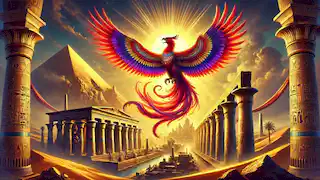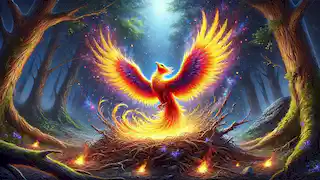The Legend of the Phoenix
Reading Time: 10 min

About Story: The Legend of the Phoenix is a Myth from egypt set in the Ancient. This Poetic tale explores themes of Perseverance and is suitable for All Ages. It offers Inspirational insights. A captivating Egyptian myth of renewal, death, and the eternal cycle of life. .
In the ancient land of Egypt, amidst the golden sands and towering pyramids, where the Nile River brought life to the desert and the gods walked among mortals, there lived a creature of such mythic power and beauty that its legend would transcend time. This creature was the Phoenix, known throughout the world for its symbolic cycle of death and rebirth. The story of the Phoenix became a cornerstone of Egyptian mythology and has echoed across cultures and centuries, influencing generations with its powerful message of renewal and hope.
The Phoenix was no ordinary bird. Its origins were believed to be divine, a gift from the gods, sent as a symbol of immortality, resurrection, and the eternal cycle of life. Its appearance was awe-inspiring: the bird was said to be as large as an eagle, with feathers that gleamed in brilliant shades of gold, scarlet, and purple. The sunlight seemed to dance on its plumage, creating a halo of light that surrounded the bird wherever it flew. Its eyes were like twin sapphires, deep and wise, reflecting the knowledge of ages long past.
The ancient Egyptians associated the Phoenix with the sun god Ra, the supreme deity who sailed across the sky each day in his celestial barque, bringing light and life to the world. Ra’s connection to the Phoenix was a natural one, for the bird’s cycle of death and rebirth mirrored the sun’s daily journey—disappearing each night only to rise again with renewed energy and light. This bond between the Phoenix and Ra elevated the bird to a sacred status, and its story became an integral part of the spiritual beliefs of the Egyptian people.
The legend begins in Heliopolis, the City of the Sun, a place where the priests worshiped Ra with fervent devotion. It was here, in the heart of this sacred city, that the Phoenix was believed to make its rare and miraculous appearances. According to ancient texts, the Phoenix would visit Heliopolis only once every five hundred years. The anticipation of the bird’s arrival grew with each passing century, and the signs of its return were eagerly awaited by the people.
The coming of the Phoenix was heralded by extraordinary events. The sky would darken, even in the height of day, as a brilliant comet streaked across the heavens. The waters of the Nile would begin to glow with an otherworldly light, shimmering as though the sun itself was trapped beneath the surface. In the dead of night, a strange warmth would fill the air, dispelling the chill of the desert and leaving an inexplicable sense of peace and renewal.
It was during one such cycle, thousands of years ago, that the Phoenix made its most famous appearance. The people of Heliopolis had been awaiting the bird’s arrival for generations, and as the signs of its return began to manifest, excitement spread throughout the city. The priests of Ra gathered in the great temple, preparing for the sacred rites that would honor the bird’s rebirth. Word spread to the far reaches of Egypt, drawing pilgrims and worshipers to Heliopolis, all hoping to witness the miracle of the Phoenix firsthand.
One morning, just as the first rays of the sun broke over the horizon, the Phoenix appeared. It soared through the sky with a grace that defied understanding, its wings outstretched like the arms of a god. The people below gasped in wonder as the bird circled the city, its feathers catching the light and igniting the sky in a blaze of red and gold. The Phoenix let out a cry—a haunting, melodic sound that echoed through the air, reverberating in the hearts of all who heard it. This was the call of the Phoenix, a song that transcended language and time, speaking directly to the soul.
But the Phoenix’s arrival was not just a spectacle to behold; it was the beginning of a sacred journey, a ritual that had been performed since the dawn of time. The bird’s purpose was not to remain in the skies above Heliopolis but to travel to a distant and hidden sanctuary, far beyond the borders of Egypt, where it would undergo the most profound transformation imaginable.
The Phoenix flew eastward, leaving the bustling city behind as it made its way across the vast expanse of desert. For days it traveled, never faltering, driven by an instinct that guided it to the place of its rebirth. This sanctuary was known only in legend—a secret grove nestled between towering mountains and endless dunes, where the sands whispered of forgotten gods and ancient mysteries. The entrance to this grove was guarded by the spirits of the earth, unseen forces that protected the sacred space from those who were unworthy.

As the Phoenix approached the grove, the air grew thick with the scent of frankincense and myrrh. These sacred trees, revered for their healing properties and their use in religious rites, were believed to be gifts from the gods themselves. The Phoenix settled in the center of the grove, surrounded by these ancient trees, their gnarled branches twisted and reaching towards the heavens.
Here, the Phoenix began the ritual that would mark the end of its life and the beginning of a new one. With great care, the bird gathered the finest materials from the grove: branches of frankincense and myrrh, stalks of cinnamon and sandalwood, and the delicate blossoms of rare flowers that only grew in this sacred place. It crafted a nest of unparalleled beauty and intricacy, a cradle for the flames that would soon consume it.
Once the nest was complete, the Phoenix settled within it, its body heavy with the weight of time. The bird’s once vibrant feathers had begun to dull, and its movements were slower now, more deliberate. The Phoenix’s eyes, however, remained as sharp and clear as ever, reflecting the knowledge of its destiny. It knew that this was not the end but merely a transition, a passage from one form to the next.
As the sun dipped below the horizon, casting the grove in a warm, golden light, the Phoenix let out a final, mournful cry. The air seemed to vibrate with the power of the bird’s song, and for a moment, all was still. Then, as if on cue, the nest burst into flames. The fire was unlike any other—its flames danced with a strange, ethereal glow, consuming the Phoenix and the nest in a matter of moments.
But this was no ordinary fire. It was a fire of transformation, a divine flame that did not destroy but purified. The ashes that remained were not cold and lifeless; they pulsed with energy, radiating a soft, warm light. From within these ashes, a new Phoenix began to take shape. The bird was reborn, rising from the ashes with wings outstretched, its feathers more vibrant than ever before. It was as though the very essence of the sun had infused the Phoenix, giving it new life and new strength.

The newly reborn Phoenix took flight, its wings cutting through the air with renewed vigor. It soared high above the desert, its body glowing with the warmth of the sun. The bird’s journey was not yet complete, however. It carried with it the ashes of its predecessor—the remains of its former self—which it would return to Heliopolis as an offering to Ra.
As the Phoenix flew back towards the city, the people of Heliopolis were filled with awe and reverence. They had witnessed the death and rebirth of the Phoenix, a divine event that symbolized the eternal cycle of life. When the Phoenix finally arrived at the temple of Ra, the priests received the ashes with great solemnity, placing them in a sacred vessel made of the finest gold and adorned with intricate carvings of the sun god’s image.
The ashes were then placed on the altar, where they would remain for all eternity, a reminder of the Phoenix’s journey and the promise of rebirth that it brought to the world. The people of Heliopolis rejoiced, for the Phoenix’s return signaled a time of prosperity and renewal. The fields were fertile, the Nile overflowed with life-giving water, and the gods smiled upon the land.
The Phoenix’s story became a central part of Egyptian mythology, a tale passed down through generations. It was inscribed on the walls of temples and tombs, and depicted in art and sculpture. The bird’s image became a symbol of immortality, appearing on amulets, jewelry, and burial artifacts, all designed to guide the soul on its journey to the afterlife.
But the legend of the Phoenix did not remain confined to Egypt alone. As the centuries passed, the story of the Phoenix spread to other lands and other cultures. The Greeks, captivated by the idea of resurrection, adopted the Phoenix into their own mythology. They believed that the bird represented immortality and the cycle of the cosmos, with the Phoenix rising and falling in tune with the stars.
In China, the Phoenix took on a new form as the Fenghuang, a mythological bird of great beauty and virtue. The Fenghuang was seen as a symbol of peace and harmony, often depicted alongside the dragon, representing the balance of male and female energies. The Phoenix’s message of renewal and hope resonated deeply with the Chinese people, who embraced the bird as a symbol of their own beliefs in the eternal nature of the universe.

In the Christian tradition, the Phoenix became a symbol of Christ’s resurrection and the promise of eternal life. Early Christians used the image of the Phoenix in their art and literature to convey the idea that death was not the end, but a gateway to a new and better existence. The Phoenix’s ability to rise from its own ashes became a powerful metaphor for the resurrection of the soul and the triumph over death.
Throughout history, the Phoenix has continued to inspire and captivate the human imagination. Its story has been retold in countless ways, from epic poetry to modern literature, from ancient carvings to contemporary artwork. The Phoenix remains a
timeless symbol of resilience and the power of the human spirit to overcome adversity.
In Egyptian culture, the Phoenix’s journey was more than just a myth; it was a reflection of the human experience. The Egyptians believed that just as the Phoenix could rise from its ashes, so too could the human soul. Death was not to be feared but embraced as part of the cycle of life. The practice of mummification, with its elaborate rituals and ceremonies, was deeply influenced by this belief in the eternal nature of the soul.
The Phoenix’s flame continues to burn brightly in the hearts of those who believe in the power of renewal and transformation. It serves as a reminder that no matter how dark the times may seem, there is always the potential for rebirth. The Phoenix rises from its ashes, not just once, but again and again, a testament to the eternal cycle of life, death, and renewal.

In modern times, the legend of the Phoenix has found new relevance. It has become a symbol of personal resilience, of the ability to rise above life’s challenges and emerge stronger than before. The Phoenix’s story speaks to the enduring nature of the human spirit, the belief that even in the face of overwhelming odds, there is always the possibility of a new beginning.
The tale of the Phoenix reminds us that we are all part of a greater cycle, that life is a journey of continuous growth and transformation. Like the Phoenix, we too must go through our own trials and tribulations, shedding the old to make way for the new. And when we rise from the ashes, we do so with a renewed sense of purpose and strength.

















